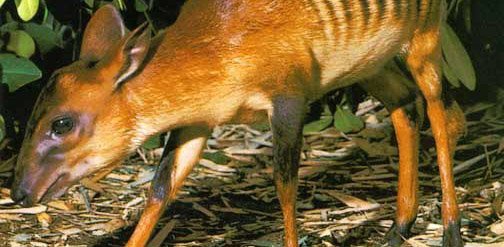The lion is one of the most famous animals on earth since it is frequently used to symbolize strength and braveness.
When describing some of the unique features that make lions be considered the kings of the jungle, you’ll likely talk about their strong paws, sharp claws, two-inch fangs, the males’ majestic mane and muscular body that weighs approximately 200kgs (500lbs).
There’s a high possibility that you’ll forget to mention its tongue in the list. Unfortunately, the lion tongue is not usually given its deserved credit as part of the body parts that make it one of the earth’s most powerful creatures.
This article aims to rectify this issue by providing comprehensive details on the lion tongue. You’ll be surprised to learn that its tongue is one of creation’s most marvelous and intricate wonders.
The Unique Features of a Lion’s Tongue
A lion’s tongue is a muscle wrapped in skin and coated in small, backward-facing spikes called papillae. It’s these papillae that make their tongue as rough as sandpaper.
Domestic cat owners are well aware of the Felidae species’ roughness compared to those of dogs or other animals. But to get an idea of the actual texture of a lion’s tongue, you’ll need to multiply the roughness of a cat’s tongue by approximately fifty times.
Also read: Do Lions Eat Grass? The Answer Might Surprise You!
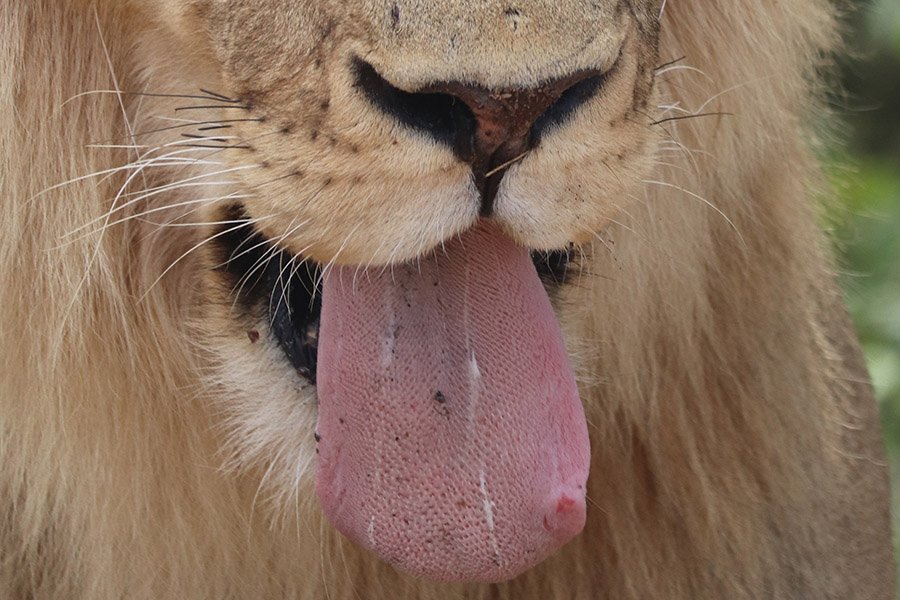
The Papillae on Lions’ Tongues
Papillae are hollow keratin structures; keratin is a protein-based fibrous molecule found in nails, claws, and hair.
However, the unique feature that makes the lion papillae distinct from those of other animals is that they are hard, sharp, hooked, and can be bent backward in their mouth compared to the typical round and soft ones in most species.
The papillae are linked to the soft, flexible skin of the tongue, enabling it to twist and change its direction. They improve their efficiency when scouring and scraping through fur or flesh while preventing the tongue from wear and tear.
They are also effective at removing tangles and knots from their prey’s fur without straining or snagging.
The Functions of a Lion’s Tongue
Feeding
After capturing and killing their prey, the lion starts to lick it to remove the animal’s fur or feathers, to get to the soft flesh beneath. The spikes also help it tenderize the flesh.
Since saliva is present in the tongue, licking also helps by kicking-starting the disintegration and digestion and the meal.
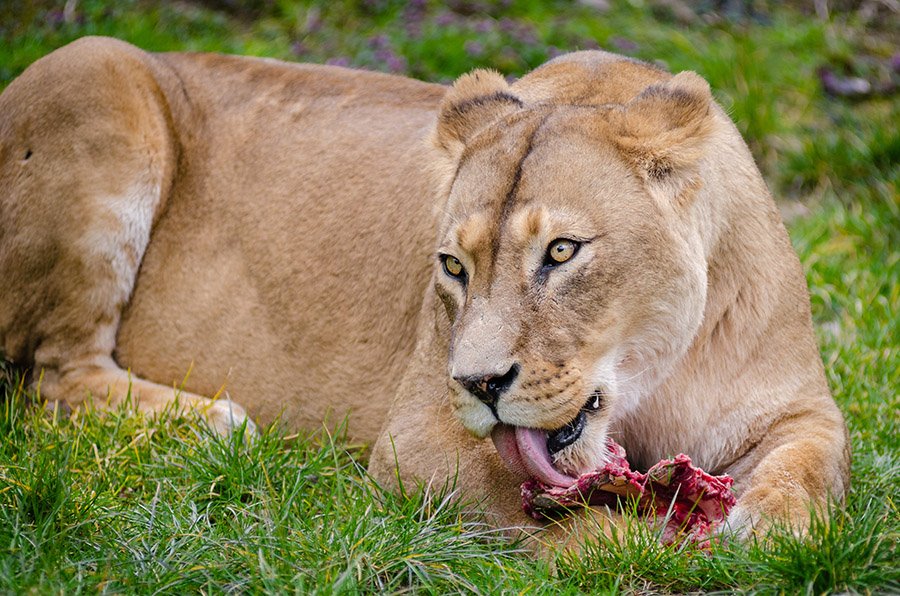
Drinking
Similar to most animals, the lion uses its tongue to drink water. If you see them drinking, you would assume they are just tasting the water since they typically insert a small portion of the tongue (the tip) in water.
However, there is a complex application of physics to this method that you need to understand. The inserted tip of the lion’s tongue in water helps it draw a substantial amount.
When it withdraws the tongue, it absorbs large liquid columns. The papillae’s extensive pores act like small cups enabling them to absorb plenty of water in a single lap.
It’s the major reason why they are said to efficiently lap in more water compared to other cat family animals.
Also read: What Eats Lions? Their Top 5 Natural Enemies
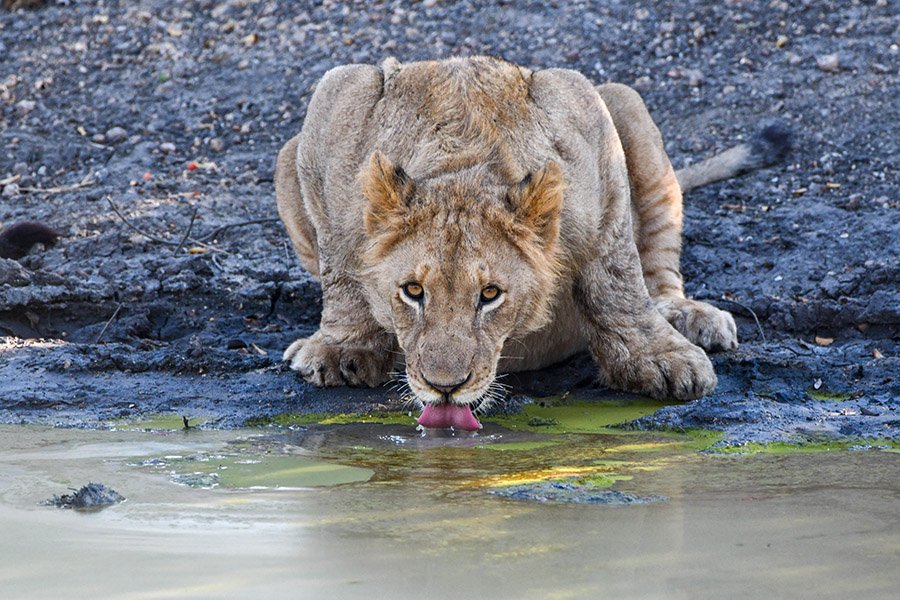
Grooming
One of the most common characteristics of all the Felidae species is their use of the tongue in grooming since we have all seen cats lick their bodies to clean themselves.
Since lions usually live in the savanna (apart from those in zoos), they are exposed to dust, dirt, and unwanted things that may be trapped in their furs. Fortunately, their tongues are well adapted to eliminate all these items.
The sharp spikes (papillae) make their tongue similar to a hair comb enabling them to brush off and remove all the unwanted things from their fur.
They also lick themselves to conceal their body odor, which helps them camouflage as it makes it hard for their prey to smell and detect their presence when hunting.
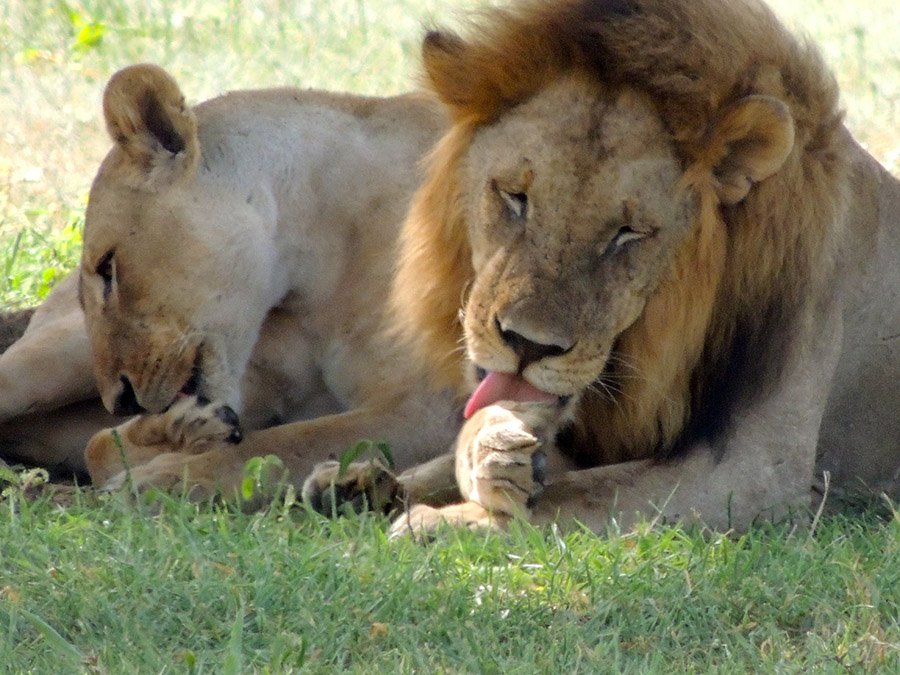
Socialization
The basic social system of lions is resident prides, which inhabit hunting grounds large enough to support their survival in the grasslands. They use their tongues to form and deepen social relationships in their pride.
By licking all the lions in their pride, the alpha male establishes a unique scent from its saliva, which enables it to mark and recognize its pride. Members of the same unit also lick each other while grooming, thus strengthening their bond.
Also read: Are Lions Friendly? Can They Be Nice to Humans?
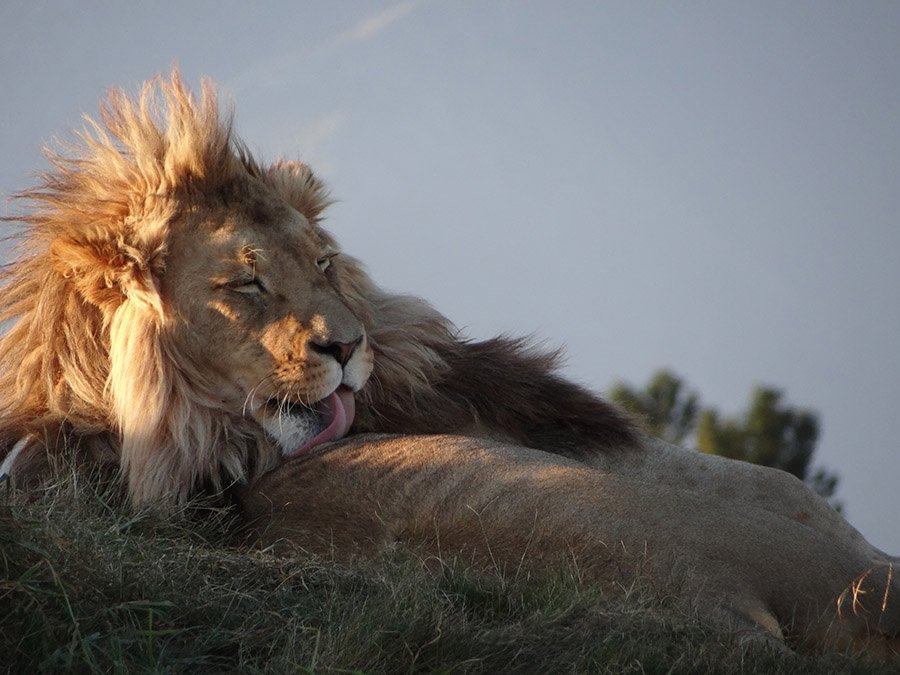
Cooling
Most of the world’s lion population is found in hot habitats such as the African savannas, where temperatures can be as high as 25-35 degrees celsius.
Therefore, they need to cool their body temperatures, and since swimming is not their favorite activity, they have to be creative to achieve this objective.
Apart from relaxing in shades provided by the jungle’s vegetation, licking their bodies is another way to stabilize their body temperatures.
The saliva in their tongues helps them to cool off during the hot days whenever they lick themselves. As the saliva evaporates, it produces a cooling effect on their bodies, thus regulating their internal temperatures despite the high heat in their habitats.
Frequently Asked Questions About The Lion’s Tongue
Can a Lion Hurt You From Its Tongue?
Although they have perfect control of their tongues and may alter their pressure as needed, it’s essential to note that YES! A lion can easily tear your skin by licking you if it applies pressure.
Their sharp spikes can remove the outer layer of human skin (epidermis) and expose your flesh. Since licking is the first step before it devours its prey, it’s essential to be cautious before you allow a lion to lick you.
How Long Is The Lion’s Tongue?
The average tongue length of a fully matured lion is approximately 8 inches long (20 cm).
Why Doesn’t a Lion Hurt Another When Licking It?
As we have seen, the pressure exerted when licking is the main determinant. Lions on the same pride tend to ease their tongue’s force when licking their counterparts during grooming or socialization.
However, the situation will drastically change if it realizes that the lion does not belong to their pride. It will apply all means possible to hurt and kill the intruder, including using maximum pressure on their tongues to cause harm.
Final Thoughts
As you can see, the lion tongue deserves to be included on the list of its majestic bodily features that have enabled them to become the most ferocious animal on the planet.
Learn More About Lions
- Lion: Characteristics, Diet, Facts & More [Fact Sheet]
- Wolverine vs. Lion: How Do They Compare & Who Wins a Fight?
- Sri Lankan Lion (Panthera leo sinhaleyus): Sri Lanka’s Forgotten Feline
- Can Ostriches Kill Lions? (Answer with Videos)
- Can Female Lions Grow a Mane? Addressing The Myth of Maned Lionesses
- Lion vs. Wildebeest: A Battle on the African Plains
- Kangaroo vs. Lion: A Fight Between Continents – Who Would Win?
- What Color Are Lions’ Eyes? Lion Eye Colors Explained
- What is Lions’ Hunting Success Rate? How Do They Compare With Other Predators?
- Lion Hybrids: A Comprehensive Overview



